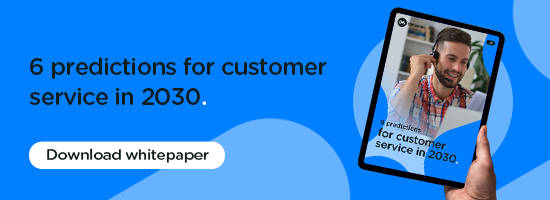However, there are a few rays of light for customer service teams and the brands behind them. The Institute of Customer Service’s UK Customer Satisfaction Index Jan 2022 found that over a third of consumers (34%) were prepared to pay more for excellent customer service, while Cheetah Digital’s 2022 Digital Consumer Trends Index found that 38% of respondents agreed that great customer service drives loyalty. So it’s clear that customer service exerts a broad influence on the external perception of businesses and can influence consumer behaviour based on its performance.
We look at the newest trends in customer service and give our take on the likely effect on consumers and businesses.
Proactive customer service
Proactive customer service anticipates rather than reacts to customer service issues. It’s about finding solutions to problems customers don’t know they have. It’s upgrading an order to a higher-spec product because your stock levels were incorrect. It’s letting customers know where to go to solve problems with their orders before they need to.
Proactive customer service is about letting the customer know about things you think they might be interested in before they’ve asked. It makes good business sense and builds customer loyalty because, let’s face it, if your customer thinks you have their best interests at heart, they’re more likely to re-order from you.
Examples of proactive support include: alerting customers to mistakes or issues, such as shipping delays and service interruptions; introducing customers to new products or services they may enjoy; or looking for ways to improve a customer's experience, such as upgrading a customer’s airline seat without them requesting it.
Customer-controlled self-service
Since the advent of smart tech, the ambition for interoperability between devices has been a major talking point for vendors and customers. We discussed self-service in our 2022 customer service trends piece, but with Gartner predicting that ‘by 2030, a billion service tickets will be raised automatically by customer-owned bots’, the future of self-service is set to be customer-controlled and automated. With smart devices interacting with one another to arrange deliveries or service calls to consumers and the customer firmly in control, automation will work to deliver on their expectations with both business and customer-controlled ‘bots focused purely on customer experience. Human service agents will have even more bandwidth to deal effectively with queries that need a personal touch, working hand-in-hand with automation to provide seamless customer experience.
That will once again raise customer expectations. With higher standards will come greater accountability and the need for greater transparency and sensitive handling of personal data. As automation ensures interoperability between multiple products and systems, sharing and interpreting customer information will become an important factor for businesses at the cutting edge of customer service.
In the shorter term, businesses need to ensure customer service teams are more accessible to consumers; no more hiding behind opaque contact forms. Brands will need to ensure they give consumers more entry points to customer service teams. Examples might include QR codes to instant WhatsApp customer service, live chat links on relevant content pages or chatbot popups on crucial conversion pages.
Voice of the Customer (VoC)
As the name suggests, Voice of the Customer is a part of customer service that’s concerned with customer feedback. There are many ways to collect VoC data, including recorded calls, surveys, chatbot transcripts, and monitoring feedback on your own or third-party websites.
Given the sheer volume of platforms consumers can voice their opinions on, automation has become more prevalent. An automated solution to aggregating feedback and providing reports regularly not only organises feedback across multiple channels but also helps to decipher it, providing trend analysis out of the box. Armed with this insight, you can accurately gauge customer sentiment and make the necessary changes to your products or services in an agile manner.
VoC helps you to uncover failings in your business and proactively fix them before they become a bigger problem.
Omnichannel service
Customers want brands to communicate with them where they are. That means keeping on top of the numerous conversational channels your customers use every day, from WhatsApp, to Google’s Business Messages to Instagram Direct Messages to Facebook Messenger and everything in between.
Monitoring all of those channels may seem like an enormous task, but with an omnichannel inbox, it’s possible to monitor conversations across multiple channels and even follow individual customer conversations should they move from one platform to another during the exchange.
Many people prefer to use different devices and channels depending on their location or the time of day. Being available across a wide variety of channels makes it easier for you to connect meaningfully with your customers and to ensure you engage with them when they need you most.
After all, 2020 research by Forrester found that 68% of consumers are more likely to purchase from a business that offers convenient communications.
Human and bot collaboration
Increasingly, businesses are seeing the benefits of automated customer service. Chatbots and voicebots can reduce the workload of stressed customer service teams by screening chats and calls and dealing with many before they need to be escalated to a human agent. With a live chat solution in place, human agents can handle a large number of queries at once, providing an efficient, productive way for agents to communicate at scale with customers.
Ultimately, the best customer service offerings are a hybrid model of human and ‘bot. This offers consumers the best of both worlds, allowing them to self-serve via automation or speak to a human where the need arises. Customer service solutions that are either 100% human or 100% automated risk frustrating customers and delivering poor service.
Internal chatbots
Most of us are familiar with customer-facing chatbots. Their increasing use by businesses to field repetitive enquiries avoids tying up human agents with simple, informational queries. However, internal chatbots are increasing in prevalence and offer an effective way of informing internal teams without resorting to costly training. These knowledge base chatbots, as they’re commonly known, allow new team members to get up-to-speed quickly, reducing the need for line management intervention.
With many customer service teams still working at least semi-remotely, the collaborative benefits of a central repository of knowledge allows teams to function independently.
Multidisciplinary teams
Allied to the benefits of knowledge base chatbots is the concept of multi-disciplinary teams. The idea is that teams are made up of a number of specialists, each aligned to a set of goals. This prevents each specialist setting (potentially counter-productive) goals based on their own skills and expertise and instead marshals the team toward a common purpose.
The upshot of all this is that each individual’s strengths complement those of the other members of the team and individual specialities come together to guide customer queries to a desirable outcome.
Customer support teams don’t work in silos, so the ability to use a variety of experiences to deduce the best outcome for an issue is invaluable. Whether working with product development and engineering or helping inform marketing strategies, the multi-disciplinary team has much more to offer when its goals are aligned.
No-code, low-code customer service tools
Hiring developers to build tech from scratch allows for endless customisation, but the development cost and time spent building a solution from the ground up can be prohibitive.
No-code, low-code offerings allow quicker, more cost-effective tech solutions without investing in a large team of developers. Aside from the obvious competitive advantage gained from being quick to market, the flexibility of no- and low-code solutions allows businesses to test hypotheses and iterate quickly.
No-code chatbots are a great example. With most of the building blocks already available on the platform, you can focus on specific business features that enhance the chatbot's effectiveness. In addition, since the code has already been tested ‘in the field’, you can dispense with a chunk of QA time and get to market faster.
Offering cutting-edge marketing and customer service platforms is one thing, but being able to advise businesses on how best to use them on a case-by-case basis is quite another. Our expert team is ready and waiting to talk you through the solutions that will keep your business at the forefront of customer service in 2023 and beyond. Get in touch today.










